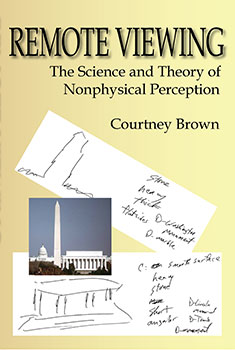|
|
Published in 2005 (revised May 2006) by FARSIGHT
PRESS (Atlanta).
These investigations utilize remote-viewing methods that are derivative of those used for decades in well-documented U.S. government funded psi research sponsored by the Central Intelligence Agency (C.I.A.) and the Defense Intelligence Agency (D.I.A.). Filled with descriptions and analyses of highly original experiments, this volume presents evidence which identifies the mental mechanism that allows an individual to perceive and describe a distant target that is not accessible to the physical processes of hearing, touch, sight, taste, and smell. Controlling for the behavioral characteristics of this mechanism now allows remote viewing to be performed with greatly improved reliability. This also leads to a better understanding of "associative remote viewing," a complex process that is required in any attempt to use remote viewing to predict numerical information, including stock market fluctuations and lottery numbers. Crucially, here is an investigation into the fascinating characteristics of time using remote viewing as a tool of exploration, offering evidence that the past, present, and future truly exist simultaneously. The idea of differing future and past time lines is not just science fiction. This research addresses the physics of psi functioning, integrating what we already know about cosmology and quantum mechanics with what we now know about remote viewing. Ultimately, this volume explains why all these new scientific revelations fundamentally affect our understanding of spirituality. The significance of the remote-viewing phenomenon to our understanding of human existence potentially rivals the significance of any previous discoveries in the history of science. This is "paradigm busting" science, and it seems destined to fundamentally challenge our most basic assumptions of the inner workings of physical reality. Hear what others
are saying about "Remote Viewing is very relevant for academic inquiry. Indeed Brown's
book should become a classic in the years to come, studied by the future
students of this subject. He writes so clearly as to make it accessible
to prospective university and college programs. Brown's book heralds the
beginnings of the academic study of subjectivism or subjective physics.
As such it directly pertains to quantum physics, particularly the interpretations
of writers and researchers like me, Goswami, Stapp, Josephson, Walker,
Hameroff and Penrose and many others who find that consciousness and quantum
physics are intimately related. His notion of 'subspace' is particularly
relevant, and physicists should be interested in his discussion."
"This book will serve as a standard reference for anyone interested
in the subject of remote viewing and its potential revolutionary impact
on our understanding of the nature of reality. Brown is in good company
with all those leading scientists who share his vision."
"Remote viewing has now entered the public consciousness with a
vengeance. (A Google search yields more than 326,000 references.) Amidst
all the hype and dubious claims, Courtney Brown has given us a serious
scientific book that not only demonstrates the reality of remote viewing
but goes beyond that to provide a set of creative hypotheses and experiments
about its underlying properties. While Brown does not shy away from discussions
of quantum physics and mathematical models, he structures the book so
that the reader can skip these details and still follow the argument.
Both the lay public and active researchers in anomalous phenomena will
find this book a source of creative and exciting ideas about psychic functioning
and the nature of the physical universe that must, perforce, permit it
to operate."
"Remote viewing, the psychoenergetic process with the best track-record
for replicability, has reached an important level of scholarly maturation
with Professor Courtney Brown's latest book, Remote Viewing.
It is an excellent contribution to this specific area of research and
to the newly appreciated field of psychoenergetic science in general."
"It is very refreshing to see the subject of remote viewing treated
like science instead of seance. The work of Courtney Brown in this respect
will hopefully herald a new attitude toward this most useful and amazing
human ability." Table of Contents List of Tables
Chapter 1. The Open Mind
Chapter 3. Cross-Cutting Psi Channels in Remote Viewing
Chapter 4. The Question of Time: The Alpha Project
Chapter 5. The Repeated Trial Problem: The Lottery Revisited
Chapter 6. A Public Demonstration of Scientific Remote Viewing
Chapter 7. Modeling the Subspace Perceptual Focus
Chapter 8. Remote Viewing, Cosmology, and Quantum Mechanics
Chapter 9. A Theory of Mind
Appendix to Volume: How to Construct a Target for a Public Demonstration of Remote Viewing
Glossary References Index
|
|||||||||||||||||||||||||||||||||||||||||||||||||||||||||||||||||||||||||||||||||||||
|
|||||||||||||||||||||||||||||||||||||||||||||||||||||||||||||||||||||||||||||||||||||||




